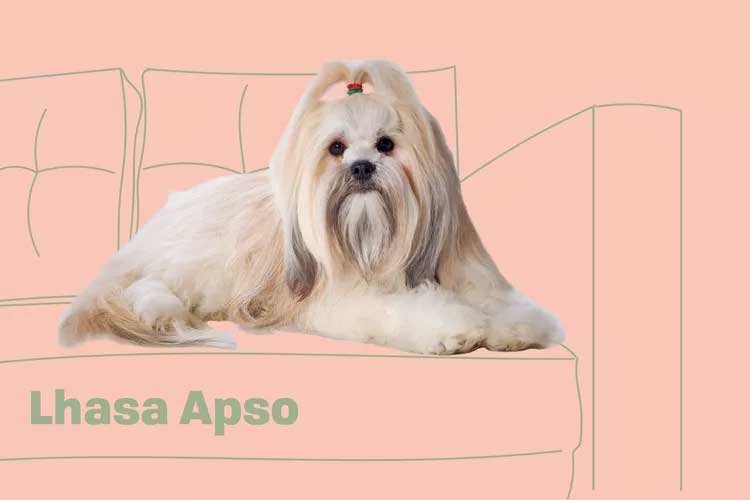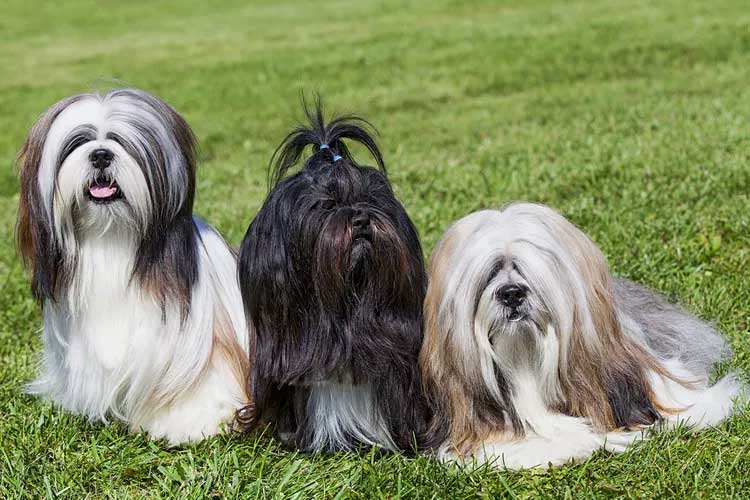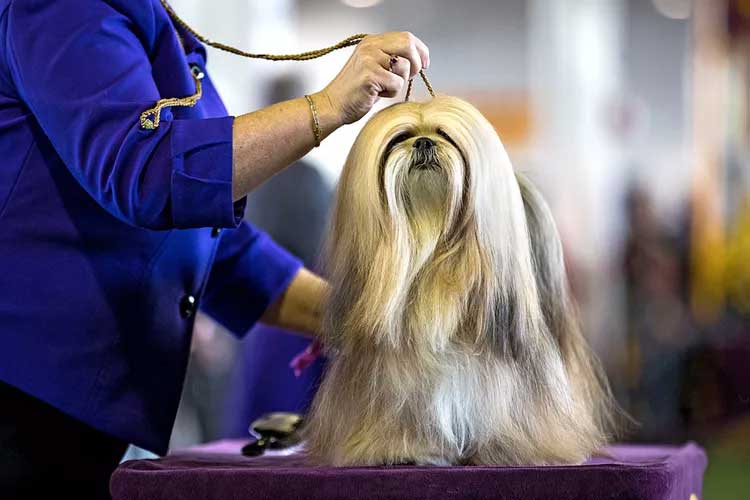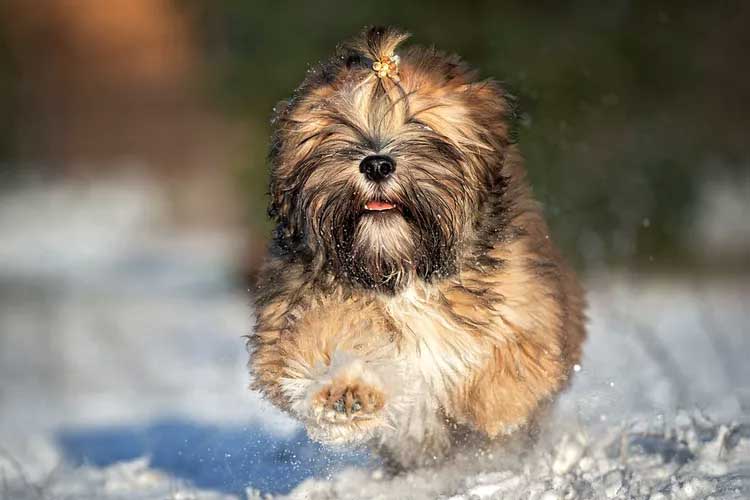Lhasa apsos are small, confident dogs filled with personality who make smart and loyal companions.

Lhasa Apso Overview
| OFFICIAL NAME | Lhasa Apso |
| COMMON NAME | Lhasa Apso |
| PET HEIGHT | 10 to 11 inches |
| PET WEIGHT | 12 to 18 pounds |
| LIFESPAN | 12 to 15 years |
| GOOD WITH | children, families, seniors |
| TEMPERAMENT | aloof, friendly, willful |
| INTELLIGENCE | high |
| SHEDDING AMOUNT | occasional |
| EXERCISE NEEDS | medium |
| ENERGY LEVEL | calm |
| VOCAL LEVEL | frequent |
| DROOL AMOUNT | low |
| BREED GROUP | non-sporting |
| BREED SIZE | small (0-25 lbs.) |
| COAT LENGTH | long |
| COLORS | black, blue, brown / chocolate / liver, cream, gold / yellow, gray, red, white |
| PATTERNS | black and tan, brindle, sable |
| OTHER TRAITS | apartment-friendly, cold weather tolerant, requires lots of grooming, strong loyalty tendencies, tolerates being alone |
The Lhasa apso (pronounced "LAH-suh-AHP-so") is a smart and willful small dog with a big personality. They're often described as funny, merry, and eager to please. Originating in Tibet, the Lhasa was bred to be a watchdog in palaces and Buddhist monasteries high in the Himalayas. Lhasa comes from the city in Tibet and apso is a Tibetan word that loosely translates to "dog." This ancestry reveals itself in the modern-day Lhasa—they're alert and loyal to their owners, though often wary of strangers.
The Lhasa is known for her long, straight, dense coat and signature hair part that gives her a lion-like mane to match her lionhearted spirit. Owners should expect to brush their dogs regularly to keep them happy and healthy for the duration of their above-average lifespan.
Cost varies widely based on a number of factors (including location), but Don Evans, president of the American Lhasa Apso Club (ALAC), says you can expect to pay between $1,400 and $1,800 for a puppy from a reputable breeder.
Appearance
Full-grown male Lhasa apsos are about 10–11 inches tall and weigh 12–18 pounds, while female pups are slightly smaller. Lhasa apsos have gorgeous black, tan, cream, white, and/or red-colored coats, but they can also be blue, gray, and silver, though those are less common.
Their luscious locks grows long, so you might want to tie up their flowy hairdo with a scrunchie or give them a sweet "puppy cut" to keep fur out of their eyes. They have black and brown button noses, long beards (if their hair is kept long), and slightly longer snouts than similar snub-nosed dogs like the Pekingese.
Temperament
Lhasas have confidence and chutzpah to spare, so much so that they are known as abso seng kye ("bark lion sentinel dog") in Tibet, where they were first bred. Ask any Lhasa apso owner and they'll tell you about this little dog's smarts, though her high intelligence and independent nature can mean she's tougher to train.That said, Evans points out that their charm and faithfulness make these dogs "worth it if you're up to the challenge." Their loyalty means they'll always have your back, though they are often aloof with strangers at first—which is not surprising, since they were bred to protect palaces from intruders.

Lhasa apso puppies can take up to three years to mature emotionally. However, with a dedicated owner and lots of praise and positive reinforcement, their energy can be channeled into learning new things. Lhasa apsos excel in agility training courses and some have even been known to herd livestock or work as therapy dogs.
"In addition to being lovable pets, Lhasas are versatile—they can and do participate in all types of American Kennel Club events such as obedience, rally, agility, dock diving, scent work, and trick dog," Evans says.
Living Needs
Lhasas are loyal to their tribe and do well with adults and children who respect their boundaries. "Lhasas can make great family pets—even with small children—as long as the children understand (with the parents' direction) to give the dog some space," Evans says. If properly socialized and trained, Lhasas can get along with other dogs and pets, but know that the Lhasa can like to be the boss.Lhasas will tolerate being left alone for reasonable periods of time, but think twice if you have neighbors who would be disturbed by any warning barking while you're away. "They are not a 'yappy' dog, but with their keen hearing, they will alert you to unexpected events," Evans says. Their small size might make them seem like ideal apartment dogs, but their bark might prove otherwise.

Lhasas need a moderate amount of exercise. A 20-minute walk once or twice a day and some playtime in the house or yard, especially during the puppy stage, will do.
The ideal Lhasa owner is someone with "a sense of humor, intelligence, and who likes interacting with their pet," Evans says. He advises that new owners be patient and understand that just like with other dogs, it can take your Lhasa apso time to adjust to her new surroundings.
Care
When it comes to grooming, the Lhasa apso is definitely high-maintenance. Though she doesn't shed much, her long and lavish coat can get quite tangled and matted if not cared for correctly—daily brushing and a bi-monthy bath is recommended. Some owners opt to keep their dog's coat short in a "puppy cut" style so that it's easier to maintain, but both hairdos are equally adorable and aww-worthy.
Lhasas will also need basic grooming every couple of weeks beyond their hair care, including nail trims and teeth brushing. Experts recommend brushing your dog's teeth every day if possible. Just make sure to use dog toothpaste, because human toothpaste is toxic for dogs! Her ears also need to be checked and cleaned regularly.
Your Lhasa should eat dog food made from high-quality ingredients. Monitoring her food and exercise is an important part of care, preventing your dog from gaining an unhealthy amount of weight. A visit to your vet can help you determine how much and how often to feed your Lhasa to keep her healthy.
Health
The Lhasa apso is a generally healthy breed but can be prone to health problems like hip dysplasia and patellar luxation. According to the American Lhasa Apso Club (ALAC), they may also deal with eye issues like retinal atrophy, pigmentary keratitis, dry eye, and glaucoma.Other common health issues for Lhasa apsos include cherry eye (a red mass at the inner corner of the dog's eye), allergies, and a genetic skin condition called sebaceous adenitis, where the sebaceous glands become inflamed. Lhasa apsos can also be susceptible to hemorrhagic gastroenteritis (HGE), a life-threatening disease that can occur in small and medium-sized dog breeds, according to the ALAC. If you catch the warning signs (like bloody diarrhea) early, the condition can be cured.

With the right care, Lhasa apsos live long lives—about 12–15 years on average. Some have even been reported to have lived well into their 20s.
If you buy a Lhasa from a breeder, it's important that they be reputable and dedicated to maintaining healthy animals. The Lhasa apso breeder should be able to show you lineage records that prove their dogs are healthy enough for breeding.
History
Lhasa apsos have a regal history that begins in 800 B.C. Tibet, when they were bred as sentinel dogs who stood watch inside palaces and Buddhist monasteries high in the Himalayan mountains, according to the ALAC. Legend has it, the brave little Lhasa apsos inspired this ancient Tibetan saying: "If the snow-lion stays in the mountains, it is a snow-lion; if it comes down to the valleys, it becomes a dog."
Lhasas have held popular status with Buddhist monks and Dalai Lamas over the centuries—they were never sold, and thus a highly prized gift. Some Tibetian Buddhists believe that the souls of lamas (priests) are reborn as Lhasa apsos in the stage of reincarnation just before they are reborn as humans, according to the ALAC.
Lhasa apsos first came to the West in the early 19th century, landing in the U.S. (specifically, New Jersey) in 1933 after being gifted to a couple by the Dalai Lama. The American Kennel Club recognized the breed just two years later, and the ALAC was founded in 1959.
Fun Facts
Centuries ago, Dalai Lamas gifted Lhasas, often in pairs, to the emperors of China because they were thought to bring good luck and prosperity.A parent breed of the shih tzu, Lhasas were bred with Pekingese to form these watchdog descendants of China.
The regal Lhasa has famous owners including Gwen Stefani, Ellen Degeneres, and Jane Lynch. Elizabeth Taylor, Kurt Vonnegut, and Liberace were also huge fans, according to the AKC.